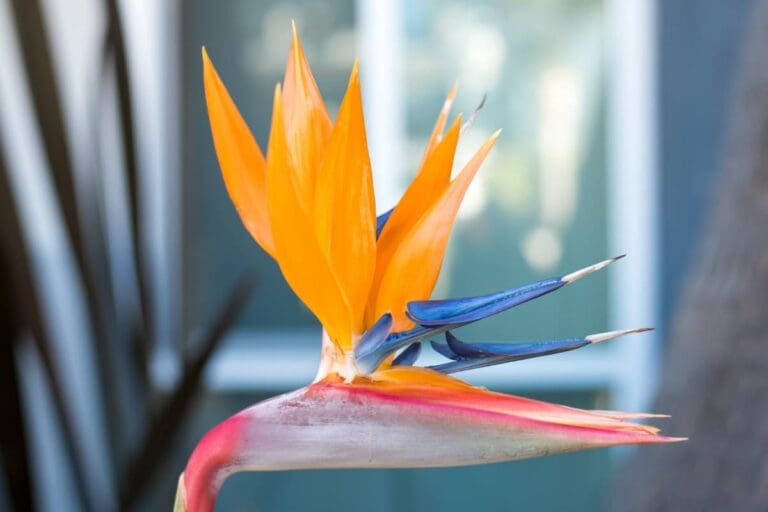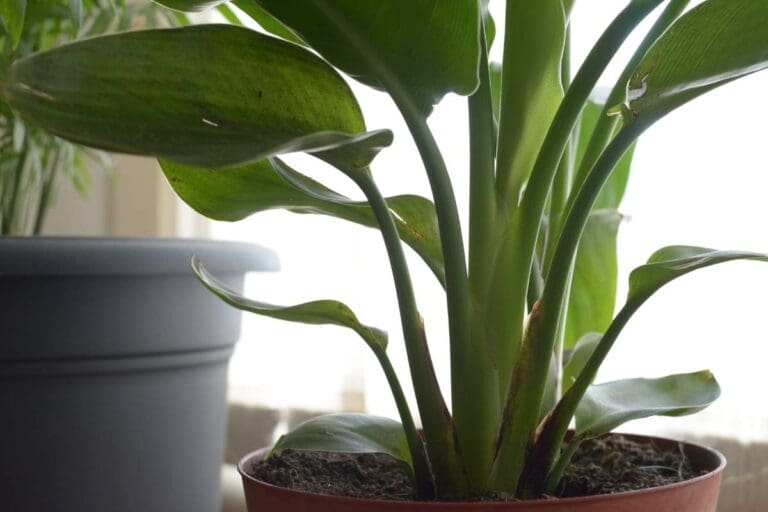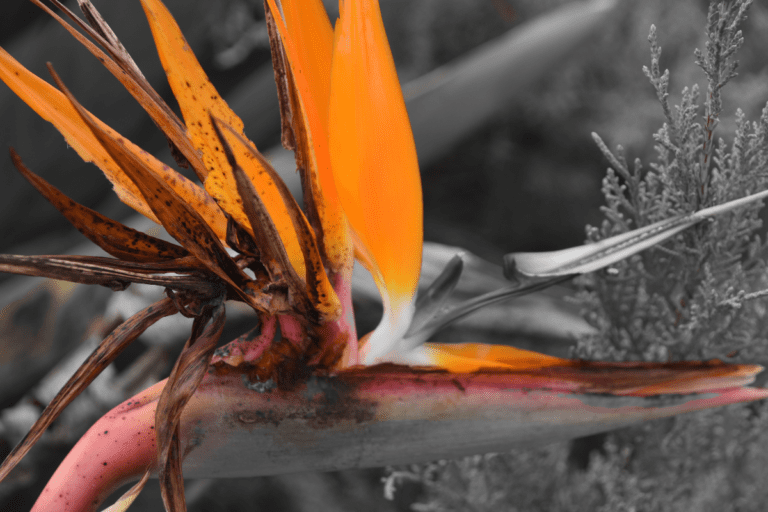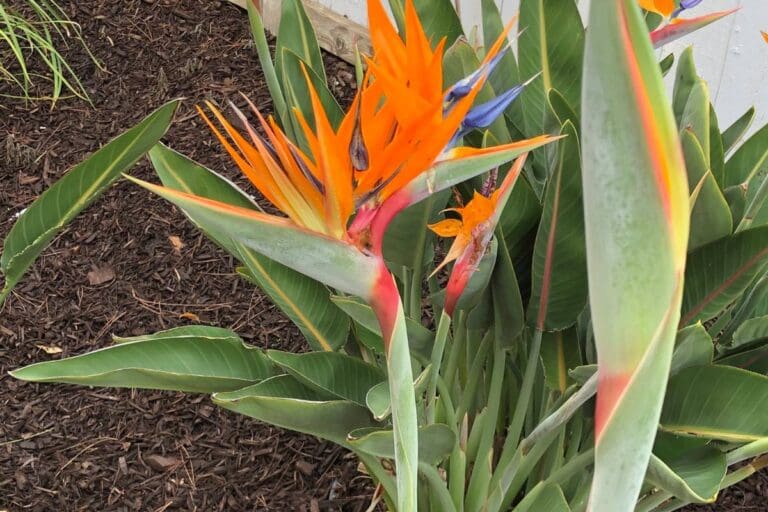10 Care Tips For Bird of Paradise
With their evergreen lush, gigantic leaves, birds of paradise plants are indeed the queen of indoor plants. If you want one for your indoor space, you will be happy to know they require significantly less care and flourish if they receive suitable conditions.
Birds of paradise grow best under ample sunlight. Refrain from overwatering and only water when the soil feels dry. These plants enjoy a lot of humidity around them, so installing a humidifier is highly recommended. Their best growth occurs between 65-85°F with loose, well-draining potting soil.
Knowing the correct care routine is essential to keep birds of paradise happy inside your home. This article will discuss all the primary care requirements to keep this plant happy.

Please note: Simplify Plants is reader-supported. Some links in the post are affiliate links and I get a commission from purchases made through links in the post.
How do I keep my birds of paradise healthy?
Birds of paradise plants are native to South Africa and closely resemble banana plants.
They immediately add a dash of tropical vibes to any indoor space with their vast glossy leaves, which are hard to miss.
The massive leaves grow upright directly from the soil, so they have no trunk.
The leaves vary in size between 2 inches to 18 inches long.
The split in their leaves need not concern you because they help the plant prevent tearing during a strong gust of winds and let the wind pass by without deforming the leaf shape.
In the right conditions, they reward you with gorgeous orange flowers, which give them their name.
They are incredibly hardy and very little demanding.
If you can provide them with the right growing conditions, they will reward you with vibrant flowers that can reach up to a height of 20 feet.
These flowers usually bloom around late winter and early spring in the best conditions, but even if your plant does not bloom indoors, its majestic leaves are enough to be the showstopper.
One word of concern if you are a pet parent is that these plants can be highly toxic to cats and dogs if ingested and cause mild to severe problems.
So let us start discussing the conditions your plant needs.
1. Choose a spot with bright natural light

Birds of paradise plants are adaptable to many lighting conditions, from medium to direct sunlight; however, it shows the best growth under a lot of natural bright sunlight.
Depending on the temperatures, it thrives in indirect to full sun.
Though they can grow in medium or indirect sunlight, their total growth will occur only under direct sunlight.
Under lower light, the plant will not flower and may produce smaller leaves.
However, it is recommended to protect this plant from the scorching hot sunlight during the afternoon, which might cause the yellowing and browning of leaves in them.
As these are huge plants, it is recommended to rotate them periodically so that all the sides of the plant get sufficient sunlight.
If the plant is not getting enough light, it might show symptoms like drooping leaves, extreme leaf splitting, browning, and newer leaves refusing to open up.
Invest in artificial lights if your home lacks sufficient natural light.
2. Let the soil dry out in between watering

Birds of paradise plants do not enjoy soggy soil.
It does best when you let the soil dry out in between watering, but at the same time, the plant does not like dehydrated soil, so the soil needs to have some moisture retention quality as well.
Alter the watering routine per the temperature and the amount of light the plant receives.
If your plant gets full sunlight, the soil will dry out quickly; if it receives indirect or partial sunlight, it stays moist for longer.
Remember to change the watering schedule as per the season; the plant will need less water during fall and winter.
So let the soil dry out in between watering as it helps the plant to breathe better.
Constantly wet clumpy soil tends to block the airflow in the soil, which suffocates the plant.
Investing in a moisture meter is advisable if you are still determining when your plant needs water.
They are devices that need to be inserted in the soil and show the moisture in the soil.
It is best to withhold watering if the soil has a high moisture content.
You can also use a tool called a soil probe which can be used to check the soil’s moisture level and also to aerate soggy soil.
Remember, underwatering is better than overwatering, which can lead to multiple problems in the plant, so water your bird of paradise only when it is thirsty.
Birds of paradise plants enjoy slightly moist soil but not wet and soggy soil, so you need to let the top layer dry out in between watering but not keep it dehydrated for a long time.
Some signs of a dehydrated bird of paradise plant are dry and crispy leaves, brittle edges, and brown and shriveled leaves.
Underwatering is easier to tackle, and the plant recovers fast once correct watering is followed.
On the other hand, signs of overwatering include browning along the edges, droopy leave, soggy clumpy soil, and so on.
Make sure to use pots with drainage holes so that the excess water of the plant does get to flow out instead of staying in the pot.
Also, you must only water this plant with filtered water.
Bird of paradise plants is sensitive to salt and mineral buildup with tap water.
They can cause issues like browning, discoloration, and spots on the leaves.
It is highly recommended that you use filtered or distilled water or rainwater to water these plants to protect them from build-ups.
3. The soil must be light and well-draining
Birds of paradise plants do not like a heavy mass of soil and prefer that it is rich, light, and loose and drains all the excess water from the soil.
They prefer soil that is loamy with a slightly acidic pH level.
An ideal soil mixture for your birds of paradise would be as below:
- 1 part good quality potting soil
- 1 part sand (to keep the soil loose)
- 1 part coco peat or peat moss (to retain and hold moisture in the soil)
- 1 part good quality compost
4. Feed the plant during its growing season

Fertilizers are a vital part of the plant care routine, which helps to feed the plant with necessary nutrients.
Birds of paradise plants need heavy feeding to push out the majestic foliage and flowers.
You must feed your birds of paradise when they are highly active in the growing season.
You can fertilize it with a 10:10:10 NPK well-balanced houseplant fertilizer once a month diluted to half strength or with good quality compost early in spring to boost its growth.
Do not fertilize in winter as the plants remain dormant, and it can lead to burns.
5. Maintain high humidity around the plant
Birds of paradise plants thrive in humidity.
They do not like dry air; thus, if your home has dry air, you must invest in ways to increase the humidity levels in your home.
Let me quickly discuss the various ways to increase humidity around your plant:
- Humidifiers– Humidifiers are amongst the best and most reliable ways to increase humidity around plants. Place the device around your plant to increase humidity for a long time.
- Pebble trays– Pebble trays are another effective way to increase humidity. All you need is a big plate or tray and a layer of pebbles on it. Now fill the tray with water and place the pot on it. As the water evaporates, the humidity levels will increase.
- Misting– Birds of paradise plants enjoy getting misted as they not only help to increase the humidity level around the plant temporarily but also help clean the leaves and keep them dust free. However, ensure not to keep the leaves wet for a long time as that may attract pests and bugs.
- Relocation– Relocating your plant to a humid area in your home is another effective way. Rooms like the kitchen, bathroom, and laundry room have higher humidity; if the other parameters are met, you can keep your plant in these areas.
- Aquarium– Keeping an aquarium near the plants also helps to increase moisture due to the evaporation of the water. Also, fish feces act as excellent fertilizers.
- Grouping– Grouping humidity-loving plants create a humid comfortable zone for plants and help to increase humidity.
6. Keep the plant in a temperature range between 65-85°F
Birds of paradise plants are sensitive to frost and extreme cold, so if you happen to live in areas with harsh colds, you need to protect them during winters.
Ensure that the location you have chosen for your plant is far away from vents and drafts to protect the plant from fluctuations in temperature.
Keep the plant in a warm room that has regular room temperatures.
However, do not place the plant too close to the fireplace or any heating source.
7. Prune the plant to maintain its shape

The flowers of birds of paradise bloom for 3-4 weeks, after which they begin to droop and lose their petals and eventually die.
Trimming off these old and dead flowers is vital to stop the plant from wasting energy on them.
Also, removing the dead leaves with a sterilized pruner is advisable to help the plant use that energy to push out new leaves instead of keeping the old leaves active.
Also, if your plant grows big for your home and you need to contain its size, prune it down during early spring.
8. Repot the plant when needed
Birds of paradise plants enjoy being slightly root bound, so as per your plant’s growth, you can repot it every 2-3 years.
For repotting, choose a new pot not more than 2 inches larger than the existing pot.
Spring and early summers are the best time to repot your plants, as they are the most active months.
And the plant can overcome the shock of repotting during the active period compared to the dormant winter months.
9. Prevent and treat pests and bugs

Birds of paradise are susceptible to bugs like aphids, whiteflies, and scales.
If you notice any sign of infestation, you must act immediately.
The more you postpone, the harder it gets to treat the plant.
On noticing any signs of bugs or pest attacks, you need to use insecticidal soaps or neem oil judiciously.
Neem oil not just teats and kills bugs, but by spraying neem oil on your plant every month, you reduce the chances of pest and bug attacks.
Birds of paradise plants are prone to Botrytis Cinerea or gray mold.
This causes the development of dark spots followed by thick gray mold.
If this happens, trim the affected parts and let the plant dry out under natural light.
These plants are also prone to root rot, so you must not overwater them and let the soil dry out between watering.
10. Propagate to get more plants
Propagating plants is a great way to get more plants without spending money.
Birds of paradise plants can be propagated from their seeds or by the process of division.
The latter shows results faster than using seeds, but you need a mature plant that has bloomed previously for at least three years.
To propagate it by division method, you need to:
- For bigger plants, you need a shovel; a sharp knife would do for small plants. You also need fresh light well-draining soil mix and a new pot.
- Remove the offshoots of the new growth, which must have at least three leaves at the base, and separate the rhizomes with a knife and shovel.
- Repot it in fresh soil in the pot.
To propagate it from seeds, you need:
- Patience. Because it takes at least 2-3 months for the seeds to germinate.
- Soak them in normal water for 24-48 hours before planting them in the soil.
- Plant them in soft, loose soil not more than ½-1 inch deep and at least 3 inches apart from each other.
- Choose a location that is warm and has indirect bright light.
- Cover the pot with plastic wrap to trap the moisture inside.
- Once the seeds germinate and you see 3-4 leaves, you can transplant the baby plant to a bigger soil in fresh soil.
Bonus tips to keep the bird of paradise happy
Here are a few more tips to help you keep your Sterilitzia happy.
1. Choose the right pot size for birds of paradise

These plants are fast growers if it gets suitable conditions.
If your plant is around 3-4 feet tall, it will grow fine in a 10 inches pot; if it is over 6-6 feet tall, you would need a 14-inch pot.
Though these plants enjoy being root bound, if you see they have gotten heavily root bound, you must repot it to a pot size up in early spring.
However, keeping them slightly root-bound helps them to bloom faster, which is what many plant owners follow.
2. Overwintering
If you live in an area with freezing temperatures, exposing your plant to that cold can kill your plant.
You must shift your plant to a protected area to shield it from cold winds and frost.
If you live in areas around zone 9, where the cold weather dips briefly, you can overwinter the plant outdoors.
To do that, you need to cut off the stem and leaves of the plant down to just 12 inches above the ground.
Cover the stem with a thick layer of mulch, straw, and leaf litter as it helps to lock moisture and keep the ground warm. Now cover the pot with a breathable row cover until spring arrives, when you can remove the coverings and let your plant grow again.
3. Making it bloom
For a plant to flower, it needs to be mature.
To encourage flowering, keep your bird of paradise slightly pot-bound.
Ensure the plant gets a lot of bright full sunlight for at least 4-6 hours, and you need to feed it well in the active season.
Also, the soil must be consistently moist throughout the spring and summer but never dry.
Final words
Birds of paradise are gorgeous plants that uplift any indoor or outdoor space. If you wish to grow this beauty or own one, this article has everything you need to take good care of the plant.
Bright sunlight, consistent watering, fertilizing during the growing season, and using a well-draining potting mix are the basic requirements you must fulfill. Maintaining the right temperature and humidity and keeping an eye on the plant are a few other things you should keep in mind.
If you face any issue with your plant, inspect it thoroughly, find the exact issue, and treat the plant. Once your plant becomes healthy, provide the right growing conditions to prevent further mishaps.
Are Birds of Paradise good for home?
Birds of paradise are not only popular for their outdoor growth but also for their indoor adaptability. Although these plants grow large, they can still fit indoors and grow considerably well under the right conditions.
Where do birds of paradise grow best?
Birds of paradise grow best in a space with full sun, 65-85°F temperature, and 60-70% humidity.
Reference: Wikipedia
Recommended Garden Supplies
| Product Image | Our Recommended Gardening Supplies | Check Offers! |
|---|---|---|
Top Top
Top
Top
Top
Top
Top
Top
Top | rePotme Houseplant and Tropical Classic Potting Soil Mix | Check Offer On Amazon |
 Top
Top
Top
Top
Top
Top
Top
Top | Espoma Organic Indoor Plant Food | Check Offer On Amazon |
 Top
Top
Top
Top
Top
Top
Top
Top | GooingTop LED Grow Light 6000K Full Spectrum Clip Plant Growing Lamp | Check Offer On Amazon |
 Top
Top
Top
Top
Top
Top
Top
Top | Soil Moisture Meter | Check Offer On Amazon |
 Top
Top
Top
Top
Top
Top
Top
Top | Govee Hygrometer Thermometer, Bluetooth Enabled! | Check Offer On Amazon |
 Top
Top | LEVOIT Humidifiers for Large Room(Best For Plants) | Check Offer On Amazon |
 Top
Top
Top
Top
Top
Top
Top
Top | Upgraded DIY Automatic Drip Irrigation Kit, 15 Potted Houseplants Support | Check Offer On Amazon |
 Top
Top
Top
Top
Top
Top
Top
Top | Stainless Steel Heavy Duty Gardening Tool Set | Check Offer On Amazon |
 Top
Top
Top
Top
Top
Top
Top
Top | Bonide Insecticidal Soap | Check Offer On Amazon |
 Top
Top
Top
Top
Top
Top
Top
Top | Bonide 32 oz Spray Neem Oil for Organic Gardening | Check Offer On Amazon |
 Top
Top
Top
Top
Top
Top
Top
Top | Garden Safe Fungicide | Check Offer On Amazon |






